Texture and Geochemistry of Scheelites in the Tongshankou Deposit in Daye, Hubei, China: Implication for REE Substitution Mechanism and Multistage W Mineralization Processes
Abstract
:1. Introduction
2. Regional and Deposit Geology
3. Sample and Analytical Methods
3.1. Sample Description
3.2. Analytical Methods
3.2.1. Microprobe Analysis
3.2.2. Optical Microscopy Cathodoluminescence (OM-CL)
3.2.3. Scanning Electron Microscopy Cathodoluminescence (SEM-CL)
3.2.4. LA-ICP-MS Trace Element Analysis
4. Results
4.1. Cold Cathodoluminescence Analysis of Scheelite
4.2. EMPA Mapping of Garnet
4.3. Major and Trace Elements in Scheelites
4.4. Rare Earth Element Geochemistry
5. Discussion
5.1. W-Mo Substitution Mechanism
5.2. Multistage Ore-Forming Process—“Double Linear Grain”
5.3. Internal Texture of “Uncoordinate” Grains
6. Conclusions
- The geochemistry and OM-CL show that the W mineralization has been highly disrupted during the formation of scheelite. The skarn mineralization system has an apparent evolution in the redox environment from endoskarn (SchC) to the distal exoskarn (SchA). W-Mo concentrations have fluctuation due to the crystallization of multi-stage minerals. SchC is considered to have similar ΣREE features as intrusions with the negative Eu anomaly, whereas SchA and SchB have higher ΣREE characteristics and a comparatively high positive Eu anomaly.
- “Double linear grain”, postulated for the first time in this work, could be one of the evidences of two substitution mechanisms in a single scheelite grain, which is the typical characteristic of SchC. In addition, the cutting and filling texture in scheelites are also prominent in OM-CL images. Early endoskarn scheelites were dominated by mechanism Ca2 + + W6 + ⇌REE3 + +Nb5+ (2), in scheelite crystallization and there was no appropriate reducing environment to sustain mechanism (3) 3Ca2 + ⇌ 2REE3 + + □Ca (□Ca = Ca site vacancy). The reducing fluid metasomatized the carbonate strata, traversed and regenerated some earlier scheelites following mechanism (3), and caused a positive Eu anomaly in the late skarn stage.
- The ore formation at the Tongshankou area is a multistage process, including a porphyry system at ~143 Ma and a skarn system at ~140 Ma. The porphyry system has an obvious priority relationship in time scale compared with the skarn system and it was probably the source of both the metallogenic element and the hydrothermal fluid. According to this study, the oxidation mineralization of Cu and Mo may have different magma sources for W. Scheelites formed with mechanism (2) during the early skarn stage mineralization within endoskarn, when there was no appropriate reducing environment for fluid transportation. Both the mechanism Ca2 + + W6 + ⇌REE3 + +Nb5+ (2) and mechanism 3Ca2 + ⇌ 2REE3 + + □Ca (□Ca = Ca site vacancy) (3), indicate fluctuation in ΣREE in Tongshankou scheelite, suggesting multi-stage mineralization: At the first stage, mechanism (2) hosted within endoskarn proceeded through mechanism (3), and the ΣREE increased throughout the single systematical skarn mineralization. Those grains with uncoordinated REE characteristics might be indicative of a reducing metallogenic fluid entering the skarn system during the late stage of evolution.
- The association of skarn W mineralization with an oxidized porphyry Cu (Mo) deposit in Tongshankou could be explained by magma sources coming from various locations and being transported with distinct redox fluids. Endoskarn and exoskarn scheelites exhibit distinct growing environments and W-Mo concentrations, indicating that W may have a favorable transportation mechanism from an oxidation to a reducing environment. Mo-rich scheelites are formed from an early metallogenic fluid and when it evolved at a later stage, magma from different source regions upwelled, generating a more reducing environment, though contamination by some earlier-formed intrusions.
Author Contributions
Funding
Data Availability Statement
Acknowledgments
Conflicts of Interest
References
- Yang, Z.M.; Hou, Z.Q.; Zhou, L.M.; Zhou, Y.W. Critical elements in porphyry copper deposits of China. Chin. Sci. Bull. 2020, 65, 3653–3664, (In Chinese with English abstract). [Google Scholar] [CrossRef]
- Zhu, Q.Q.; Xie, G.Q.; Han, Y.X. Characteristics of Tungsten Mineralization from the Tongshankou Skarn-Porphyry Cu (Mo) Deposit in Daye, Hubei Province, and Its Geological implications. Earth Sci. 2019, 44, 441–455, (In Chinese with English abstract). [Google Scholar]
- He, D.; Tan, J.; Liu, X.Y.; Zhang, M.; Zhao, B.; Chen, Y.; Zhao, Y.Y. Significance of inclusions and fluid evolution of the porphyry- skarn copper-molybdenum deposit in Tongshankou, Daye, Hubei. Bull. Geol. Sci. Technol. 2020, 39, 97–108, (In Chinese with English abstract). [Google Scholar]
- Duan, D.F. Geological Character and Ore Genesis of Cu-Polymetallic Deposits Surrounding Yangxin Batholith. Ph.D. Thesis, China University of Geosciences (Wuhan), Wuhan, China, 2019. (In Chinese with English abstract). [Google Scholar]
- Han, J.S.; Chen, H.Y.; Hong, W.; Hollings, P.; Chu, G.B.; Zhang, L.; Sun, S. Texture and geochemistry of multi-stage hydrothermal scheelite in the Tongshankou porphyry-skarn Cu-Mo(-W) deposit, eastern China: Implications for ore-forming process and fluid metasomatism. Am. Mineral. 2020, 105, 945–954. [Google Scholar] [CrossRef]
- Chu, G.B.; Chen, H.Y.; Falloon, T.J.; Han, J.S.; Zhang, S.T.; Cheng, J.M.; Zhang, X.B. Early Cretaceous mantle upwelling and melting of juvenile lower crust in the Middle-Lower Yangtze River Metallogenic Belt: Example from Tongshankou Cu-(Mo W) ore deposit. Gondwana Res. 2020, 83, 183–200. [Google Scholar] [CrossRef]
- Zhou, T.F.; Fan, Y.; Yuan, F. Advances on petrogenesis and metallogeny study of the mineralization belt of the Middle and Lower Reaches of the Yangtze River area. Acta Petrol. Sin. 2008, 24, 1665–1678, (In Chinese with English abstract). [Google Scholar]
- Zhou, T.F.; Fan, Y.; Wang, S.W.; Noel, C.W. Metallogenic regularity and metallogenic model of the Middle-Lower Yangtze River Valley Metallogenic Belt. Acta Petrol. Sin. 2017, 33, 3353–3372, (In Chinese with English abstract). [Google Scholar]
- Wang, M.F.; Zhao, R.Z.; Shang, X.Y.; Wei, K.T.; An, W.W. Factors controlling Pt–Pd enrichments in intracontinental extensional environment: Implications from Tongshankou deposit in the Middle–Lower Yangtze River Metallogenic Belt, Eastern China. Ore Geol. Rev. 2020, 124, 103621. [Google Scholar] [CrossRef]
- Chang, Y.F.; Li, J.H.; Song, C.Z. The regional tectonic framework and some new understandings of the Middle-Lower Yangtze River Valley Metallogenic Belt. Acta Petrol. Sin. 2019, 35, 3579–3591, (In Chinese with English abstract). [Google Scholar]
- Zhao, X.F.; Li, J.W.; Ma, C.Q. 40Ar-39Ar geochronology of Tongshankou Cu (Mo) deposit in the Southeastern Hubei Fe-Cu Province: Implications for regional metallogeny. Acta Geol. Sin. 2006, 80, 849–862, (In Chinese with English abstract). [Google Scholar]
- Zhai, Y.S.; Yao, S.Z.; Lin, X.D.; Jin, F.Q.; Zhou, X.R. Metallogenic regularity of iron and copper in the middle and lower reaches of the Yangtze River. Miner. Depos. 1992, 11, 1–12, (In Chinese with English abstract). [Google Scholar]
- Shu, Q.A.; Chen, P.L.; Cheng, J.R. The Geology of Iron and Copper Deposits in Eastern Hubei Province; Ministry of Metallurgical Industry Publishing House: Beijing, China, 1992; pp. 1–532, (In Chinese with English abstract). [Google Scholar]
- Lv, X.B.; Yao, S.Z.; Lin, X.D. The geological characteristics and ore-forming mechanism of Tongshankou skarn- porphyry composite type of copper (molybdenum) ore deposit, Hubei. Earth Sci. 1992, 17, 171–180, (In Chinese with English abstract). [Google Scholar]
- Chu, G.B.; Zhang, S.T.; Zhang, X.B.; Han, J.S.; Zhang, Y.; Cheng, J.M.; Feng, Y.Z. Chlorite chemistry of Tongshankou porphyry-related Cu–Mo–W skarn deposit, Eastern China: Implications for hydrothermal fluid evolution and exploration vectoring to concealed orebodies. Ore Geol. Rev. 2020, 122, 103531. [Google Scholar] [CrossRef]
- He, J.Y. Mineralogical Characteristics of Ruanjiawan Scheelite Deposit. Master’s Thesis, China University of Geosciences (Beijing), Beijing, China, 2020. (In Chinese with English abstract). [Google Scholar]
- Zhao, W.W.; Zhou, M.F.; Williams, J.A.; Zhao, Z. Constraints on the uptake of REE by scheelite in the Baoshan tungsten skarn deposit, South China. Chem. Geol. 2018, 477, 123–136. [Google Scholar] [CrossRef] [Green Version]
- Jiang, X.J.; Chen, X.; Zheng, Y.Y.; Gao, S.B.; Zhang, Z.L.; Zhang, Y.C.; Zhang, S.Z. Decoding the oxygen fugacity of ore-forming fluids from garnet chemistry, the Longgen skarn Pb-Zn deposit, Tibet. Ore Geol. Rev. 2020, 126, 103770. [Google Scholar] [CrossRef]
- Yin, J.W.; Li, X.J. Characteristics of garnet in Shizhuyuan skarn deposit, Hunan province. Earth Sci. 2000, 25, 163–171, (In Chinese with English abstract). [Google Scholar]
- Gaspar, M.; Knaack, C.; Meinert, L.D.; Moretti, R. REE in skarn systems: A LA-ICP-MS study of garnets from the Crown Jewel gold deposit. Geochim. Cosmochim. Acta 2008, 72, 185–205. [Google Scholar] [CrossRef]
- Correa, R.S.; Oliveira, C.G.; Dantas, E.L.; Della Giustina, M.E.S.; Hollanda, M. The root zones of the Seridó W-skarn system, northeastern Brazil: Constraints on the metallogenesis of a large Ediacaran tungsten Province. Ore Geol. Rev. 2021, 128, 103884. [Google Scholar] [CrossRef]
- Fitros, M.; Tombros, S.F.; Kilias, S.P.; Kokkalas, S.; Perraki, M.; Skliros, V.; Simos, X.C.; Papaspyropoulos, K.; Avgouropoulos, G.; Willianms-Jones, A.E.; et al. REE-enriched skarns in collisional settings: The example of Xanthi’s Fe-skarn, Rhodope Metallogenetic Massif, Northern Greece. Lithos 2020, 370, 105638. [Google Scholar] [CrossRef]
- Yıldırım, E.; Yıldırım, N.; Dönmez, C.; Koh, S.M.; Gunay, K. Mineralogy, Rare earth elements geochemistry and genesis of the Keban-West Euphrates (Cu-Mo)-Pb-Zn skarn deposit (Eastern Taurus metallogenic belt, E Turkey). Ore Geol. Rev. 2019, 114, 103102. [Google Scholar] [CrossRef]
- de Siqueira Corrêa, R.; Oliveira, C.G.; Dantas, E.L.; Botelho, N.F. Hydrothermal footprint related to regional-scale shear zone-controlled scheelite mineralization, Seridó W-skarn system, northeastern Brazil. J. S. Am. Earth Sci. 2020, 103, 102755. [Google Scholar] [CrossRef]
- Wen, G.; Zhou, R.J.; Li, J.W.; Chang, J.; Hu, H.; Yan, D.R.; Wei, K.T.; Jin, S.G. Skarn metallogeny through zircon record: An example from the Daye Cu-Au-Fe-Mo district, Eastern China. Lithos 2020, 378, 105807. [Google Scholar] [CrossRef]
- Yang, Y.L.; Ni, P.; Wang, Q.; Wang, J.Y.; Zhang, X.L. In Situ LA-ICP-MS study of garnets in the Makeng Fe skarn deposit, eastern China: Fluctuating fluid flow, ore-forming conditions and implication for mineral exploration. Ore Geol. Rev. 2020, 126, 103725. [Google Scholar] [CrossRef]
- Wang, J.P.; Li, X.W.; Ning, W.B.; Kusky, T.; Wang, L.; Polat, A.; Deng, H. Geology of a Neoarchean suture: Evidence from the Zunhua ophiolitic mélange of the Eastern Hebei Province, North China Craton. GSA Bull. 2019, 131, 1943–1964. [Google Scholar] [CrossRef]
- Qu, K.; Sima, X.; Fan, G.; Li, G.; Shen, G.F.; Chen, H.K.; Liu, X.; Yin, Q.Q.; Li, T.; Wang, Y. Taipingite-(Ce), (Ce73+, Ca2) Σ9Mg(SiO4)3[SiO3(OH)]4F3, a new mineral from the Taipingzhen REE deposit, North Qinling Orogen, central China. Geosci. Front. 2020, 11, 2339–2346. [Google Scholar] [CrossRef]
- Wang, X.M.; Jiao, Y.Q.; Du, Y.S.; Ling, W.L.; Wu, L.Q.; Cui, T.; Zhou, Q.; Jin, Z.G.; Lei, Z.Y.; Weng, S.F. REE mobility and Ce anomaly in bauxite deposit of WZD area, Northern Guizhou, China. J. Geochem. Explor. 2013, 133, 103–117. [Google Scholar] [CrossRef]
- Lee, S.G.; Asahara, Y.; Tanaka, T.; Kim, N.H.; Yi, K.; Masuda, A.; Song, Y.S. La–Ce and Sm–Nd isotopic systematics of early Proterozoic leucogranite with tetrad REE pattern. Chem. Geol. 2010, 276, 360–373. [Google Scholar] [CrossRef]
- Qu, K.; Sima, X.; Zhou, H.; Xiao, Z.; Tu, J.; Yin, Q.; Liu, X.; Li, J. In situ LA-MC-ICP-MS and ID-TIMS U-Pb ages of bastnäsite-(Ce) and zircon from the Taipingzhen hydrothermal REE deposit: New constraints on the later Paleozoic granite-related U-REE mineralization in the North Qinling Orogen, Central China. J. Asian Earth Sci. 2019, 173, 352–363. [Google Scholar] [CrossRef]
- Ondrejka, M.; Uher, P.; Pr·Ek, J.; Ozdin, D. Arsenian monazite-(Ce) and xenotime-(Y), REE arsenates and carbonates from the Tisovec-Rejkovo rhyolite, Western Carpathians, Slovakia: Composition and substitutions in the (REE, Y) XO4 system (X = P, As, Si, Nb, S). Lithos 2007, 95, 116–129. [Google Scholar] [CrossRef]
- Taylor, S.R.; McLennan, S.M. The continental crust: Its composition and evolution. J. Geol. 1985, 94, 57–72. [Google Scholar]
- Wang, Q.; Zhao, Z.H.; Xu, J.F.; Bai, Z.H.; Wang, J.X.; Liu, C.X. The Geochemical characteristics of Tongshankou and Yinzu adakitic intrusive rocks in Southeastern Hubei: (Delamination) lower crustal melting and the genesis of porphyry copper deposit. Acta Petrol. Sin. 2004, 20, 351–360, (In Chinese with English abstract). [Google Scholar]
- Li, J.W.; Zhao, X.F.; Zhou, M.F.; Vasconcelos, P.; Ma, C.Q.; Deng, X.D.; Souza, Z.S.D.; Zhao, Y.X.; Wu, G. Origin of the Tongshankou porphyry–skarn Cu–Mo deposit, eastern Yangtze craton, Eastern China: Geochronological, geochemical, and Sr–Nd–Hf isotopic constraints. Miner. Depos. 2008, 43, 315–336. [Google Scholar] [CrossRef]
- Raimbault, L.; Baume, A.; Dubru, M.; Benkerrou, C.; Zahm, A. REE fractionation between scheelite and apatite in hydrothermal conditions. Am. Mineral. 1993, 78, 1275–1285. [Google Scholar]
- Kozlik, M.; Raith, J.G. Variscan metagranitoids in the central Tauern Window (Eastern Alps, Austria) and their role in the formation of the Felbertal scheelite deposit. Lithos 2017, 278, 303–320. [Google Scholar] [CrossRef]
- Kozlik, M.; Raith, J.G.; Gerdes, A. U–Pb, Lu–Hf and trace element characteristics of zircon from the Felbertal scheelite deposit (Austria): New constraints on timing and source of W mineralization. Chem. Geol. 2016, 421, 112–126. [Google Scholar] [CrossRef]
- Brugger, J.; Maas, R.; Lahaye, Y.; McRae, C.; Ghaderi, M.; Costa, S.; Lambert, D.; Bateman, R.; Prince, K. Origins of Nd–Sr–Pb isotopic variations in single scheelite grains from Archaean gold deposits, Western Australia. Chem. Geol. 2002, 182, 203–225. [Google Scholar] [CrossRef]
- Li, J.W.; Zhao, X.F.; Zhou, M.F.; Ma, C.Q.; Souza, Z.S.D.; Vasconcelos, P. Late Mesozoic magmatism from the Daye region, eastern China: U–Pb ages, petrogenesis, and geodynamic implications. Contrib. Mineral. Petrol. 2009, 157, 383–409. [Google Scholar] [CrossRef]
- Silva, M.M.V.G.; Lopes, S.P.; Gomes, E.C. Geochemistry and behavior of REE in stream sediments close to an old Sn-W mine, Ribeira, Northeast Portugal. Geochemistry 2014, 74, 545–555. [Google Scholar] [CrossRef]
- Ghaderi, M.; Palin, M.J.; Campbell, I.H.; Sylvester, P.J. Rare earth element systematics in scheelite from hydrothermal gold deposits in the Kalgoorlie-Norseman region, Western Australia. Econ. Geol. 1999, 94, 423–437. [Google Scholar] [CrossRef]
- Nilsson, K.K.; Jensen, B.S.; Carlsen, L. Geochemistry and mineralogy of rare earth elements. Rev. Mineral. 1989, 21, 72–79. [Google Scholar]
- Sun, K.K.; Chen, B. Trace elements and Sr-Nd isotopes of scheelite: Implications for the W-Cu-Mo polymetallic mineralization of the Shimensi deposit, South China. Am. Mineral. 2017, 102, 1114–1128. [Google Scholar]
- Sato, K. Tungsten skarn deposit of the Fujigatani Mine, Southwest Japan. Econ. Geol. 1980, 75, 1066–1082. [Google Scholar] [CrossRef]
- Brugger, J.; Etschmann, B.; Pownceby, M.; Liu, W.; Grundler, P.; Brewe, D. Oxidation state of europium in scheelite: Tracking fluid–rock interaction in gold deposits. Chem. Geol. 2008, 257, 26–33. [Google Scholar] [CrossRef]
- Song, G.X.; Qin, K.Z.; Li, G.M.; Evans, N.J.; Chen, L. Scheelite elemental and isotopic signatures: Implications for the genesis of skarn-type W-Mo deposits in the Chizhou Area, Anhui Province, Eastern China. Am. Mineral. 2014, 99, 303–317. [Google Scholar] [CrossRef]
- Hou, Z.Q.; Yang, Z.M. Environmental porphyry deposits in Chinese mainland: Basic geological characteristics, magmatic hydrothermal systems and metallogenic conceptual models. Acta Geol. Sin. 2009, 83, 1779–1817, (In Chinese with English abstract). [Google Scholar]
- Hou, Z.Q.; Yang, Z.M.; Wang, R.; Zheng, Y.C. Further discussion on mineralization of porphyry Cu-Mo-Au deposit in Chinese mainland. Earth Sci. Front. 2020, 27, 20–44, (In Chinese with English abstract). [Google Scholar]
- Sylvester, P.J. Post-collisional strongly peraluminous granites. Lithos 1998, 45, 29–44. [Google Scholar] [CrossRef]
- Rapp, R.P.; Shimizu, N.; Norman, M.D.; Applegate, G.S. Reaction between slab-derived melts and peridotite in the mantle wedge: Experimental constraints at 3.8 GPa. Chem. Geol. 1999, 160, 335–356. [Google Scholar] [CrossRef]
- Sen, C.; Dunn, T. Dehydration melting of a basaltic composition amphibolite at 1.5 and 2.0 GPa: Implications for the origin of adakites. Contrib. Mineral. Petrol. 1994, 117, 394–409. [Google Scholar] [CrossRef]

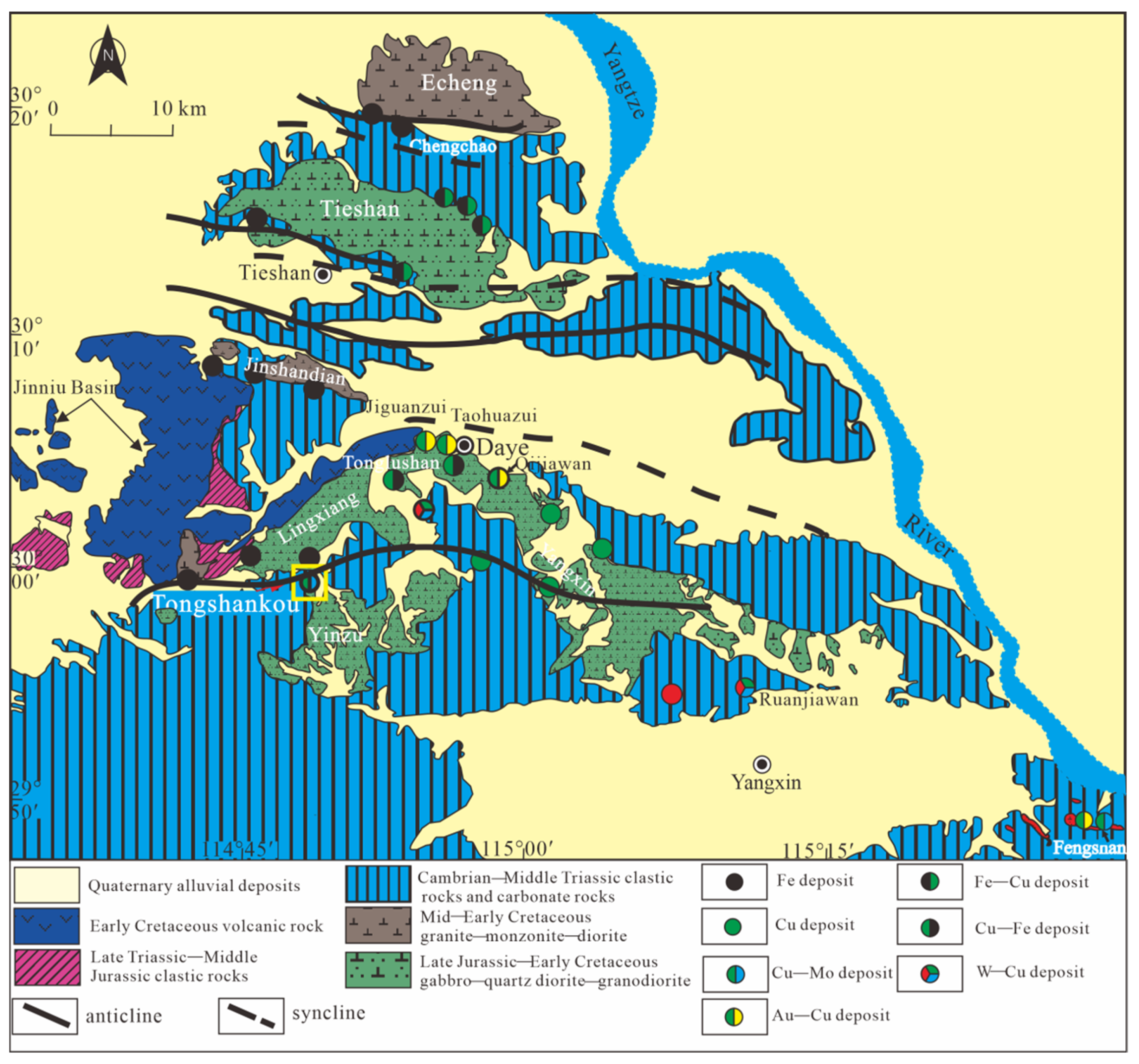
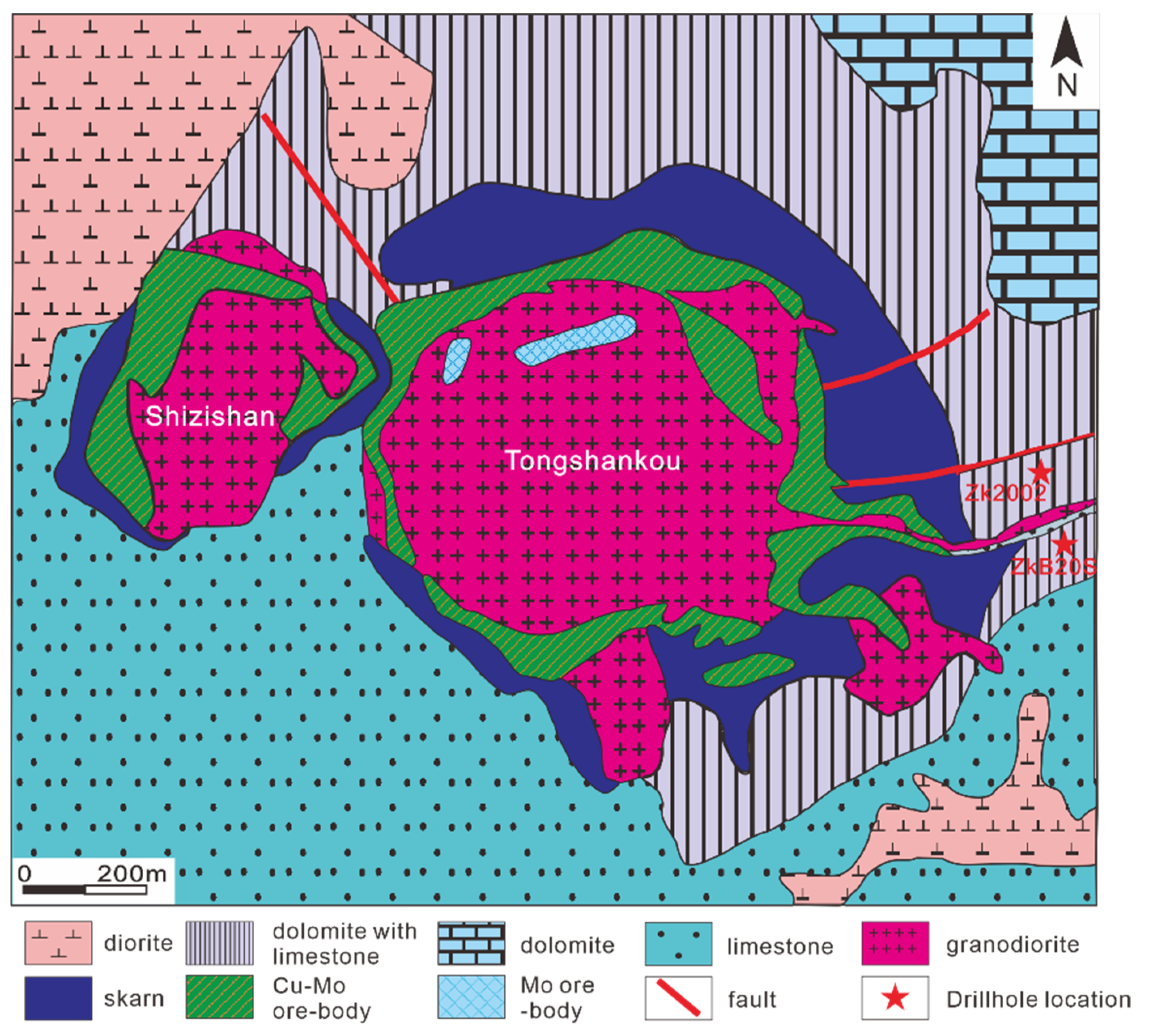
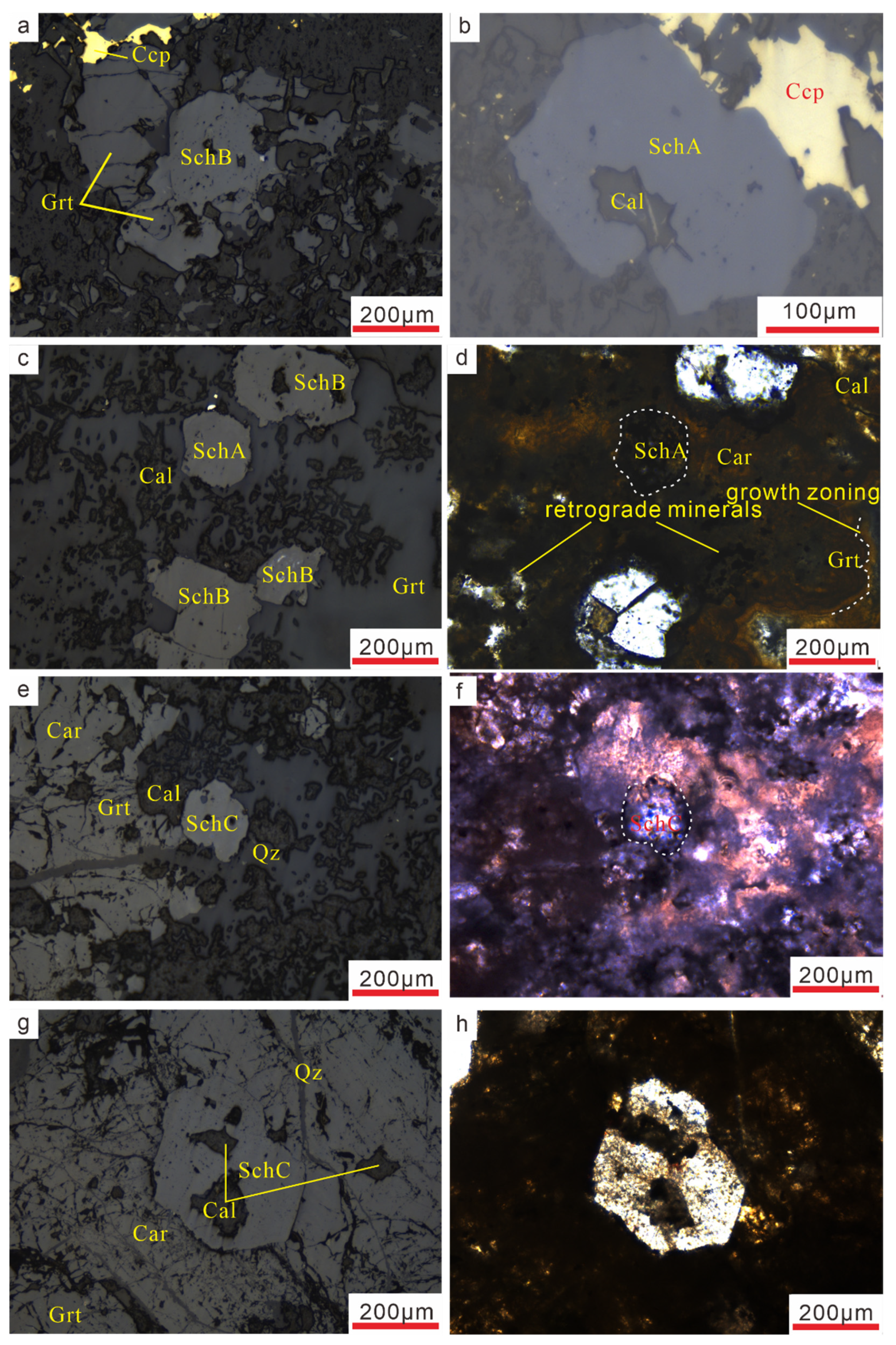
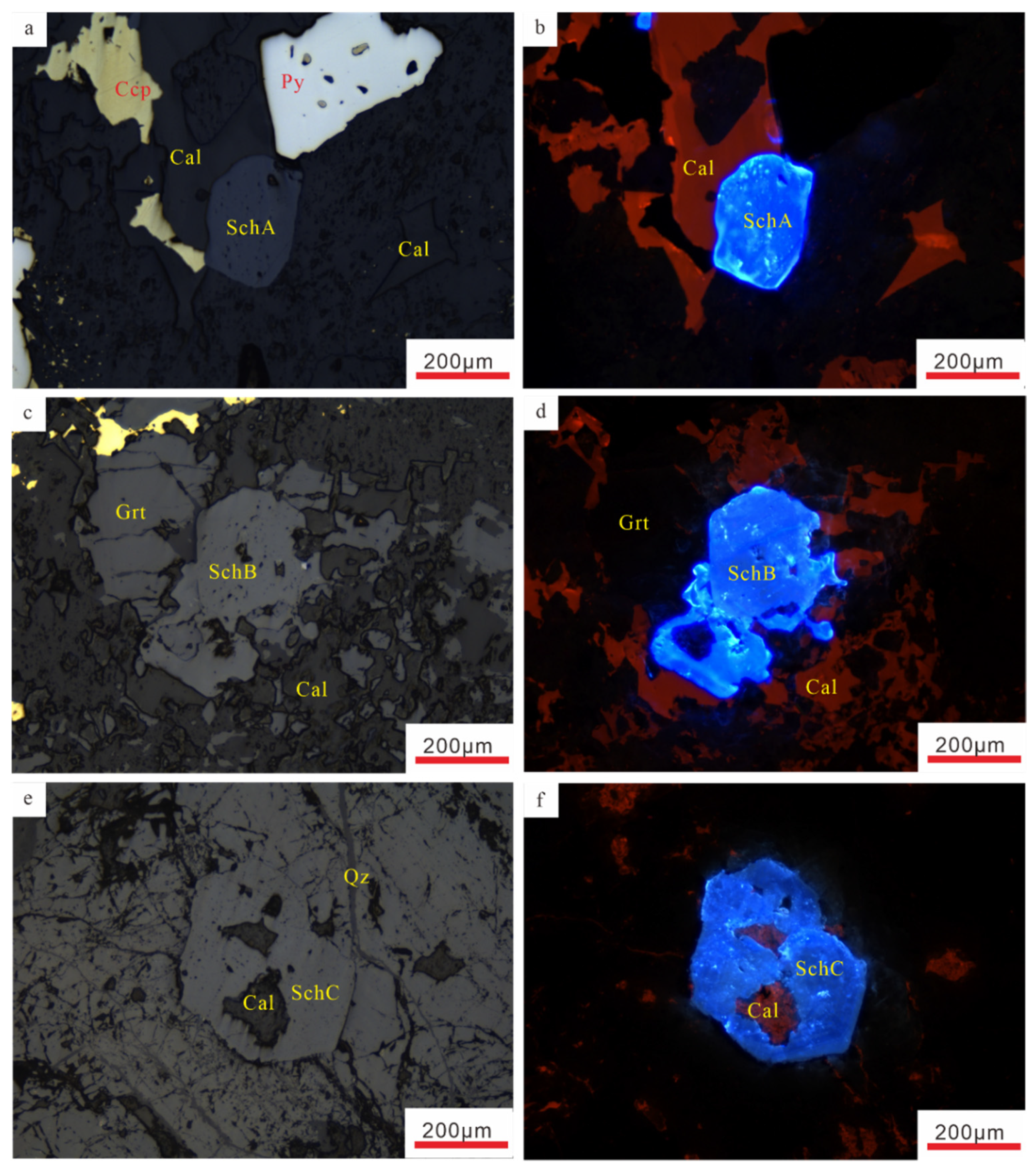
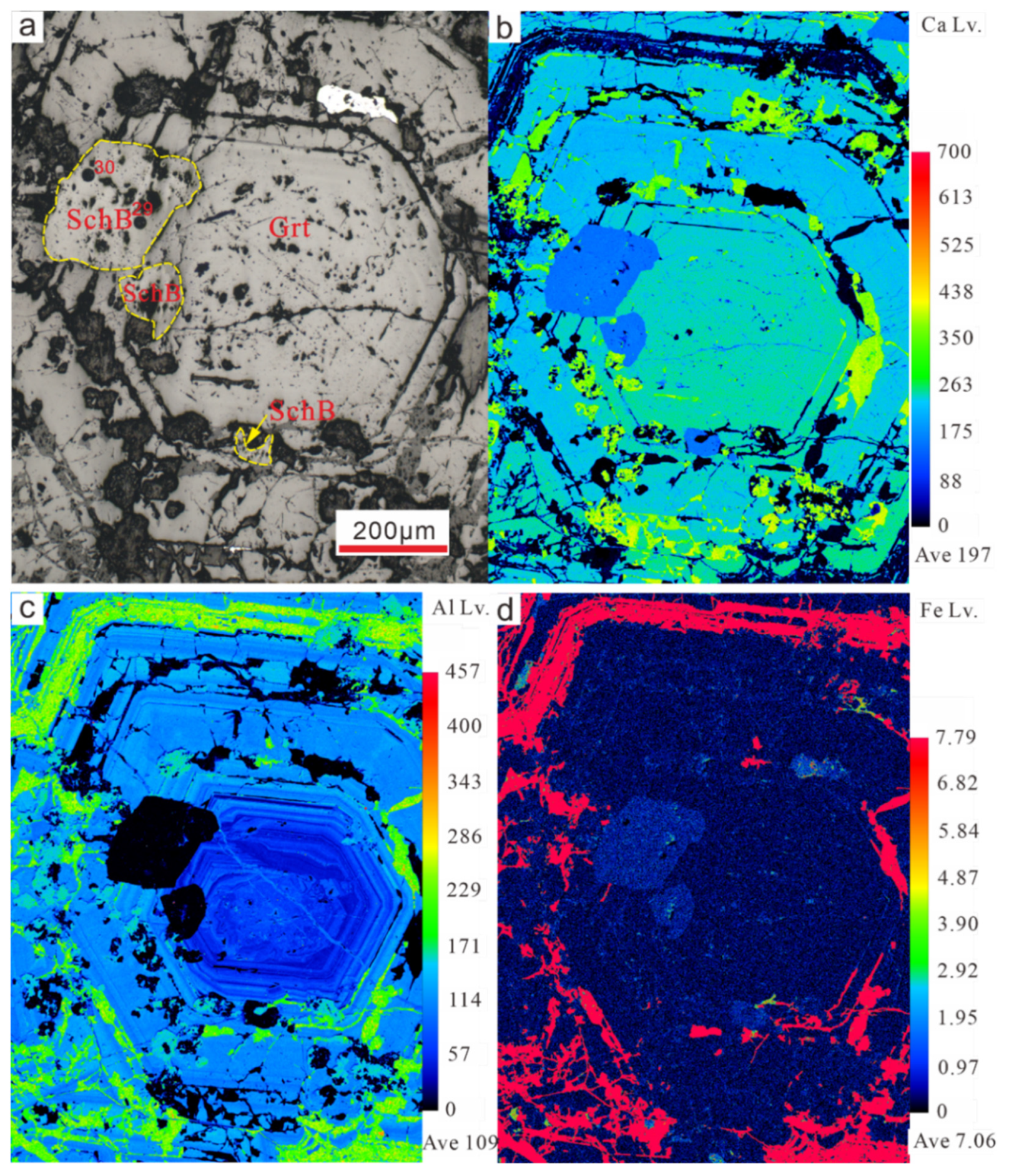

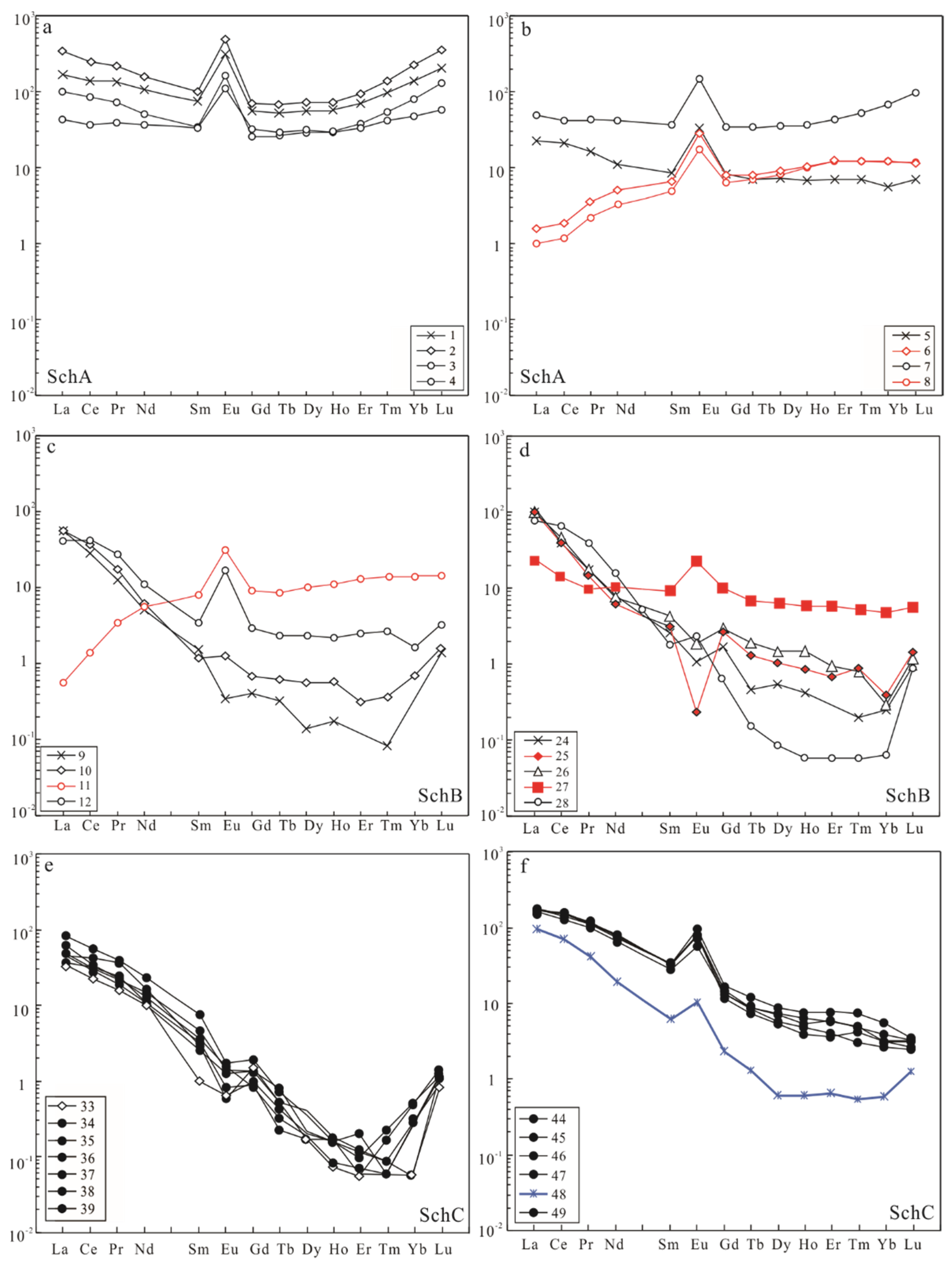
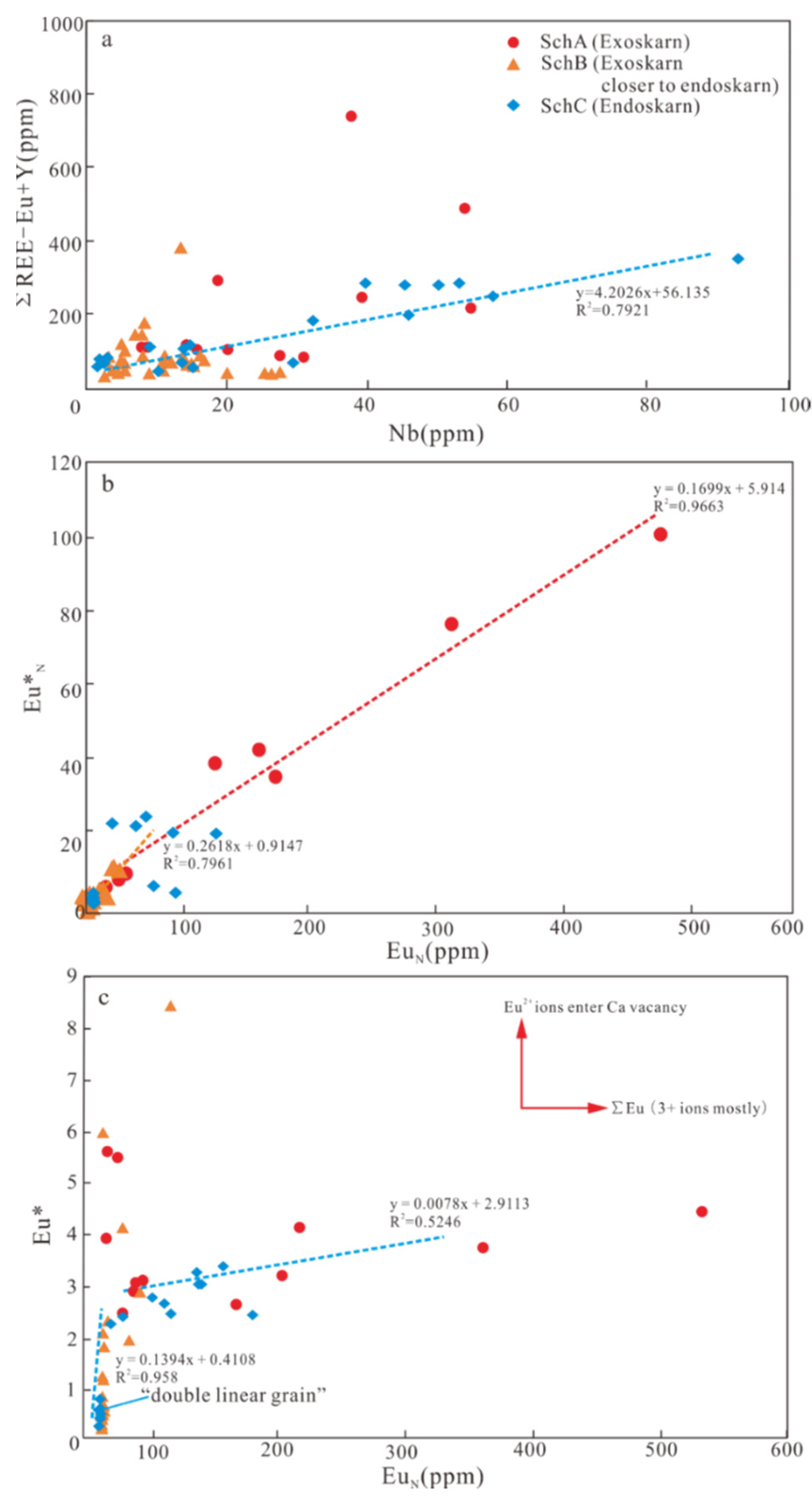


| Sample No. | Spot No. | WO3 | MoO3 | CaO | MnO | SiO2 | P2O5 | FeOT | Total |
|---|---|---|---|---|---|---|---|---|---|
| ZK2002–1 | 1 | 68.60 | 8.540 | 20.97 | bdl | 0.160 | 0.380 | 0.070 | 98.70 |
| 2 | 56.26 | 20.11 | 22.63 | bdl | 0.160 | 0.430 | 0.470 | 100.1 | |
| 3 | 50.01 | 24.67 | 23.40 | 0.020 | 0.130 | 0.530 | 0.60 | 99.36 | |
| 4 | 52.03 | 23.26 | 22.85 | bdl | 0.180 | 0.460 | 0.190 | 98.97 | |
| 5 | 69.26 | 8.120 | 20.86 | 0.030 | 0.180 | 0.340 | 0.090 | 98.88 | |
| 6 | 73.92 | 5.610 | 19.37 | bdl | 0.300 | 0.340 | 0.660 | 100.2 | |
| ZK2002-1 | 1 | 75.02 | 3.370 | 20.56 | bdl | 0.200 | 0.230 | bdl | 99.38 |
| 2 | 74.75 | 3.750 | 20.76 | bdl | 0.210 | 0.330 | 0.020 | 99.81 | |
| 3 | 74.82 | 4.010 | 20.76 | 0.060 | 0.180 | 0.270 | 0.030 | 100.1 | |
| 4 | 75.01 | 3.720 | 20.67 | 0.020 | 0.200 | 0.240 | 0.020 | 99.88 | |
| 5 | 70.44 | 7.220 | 20.88 | 0.020 | 0.160 | 0.350 | bdl | 99.07 | |
| 6 | 74.07 | 4.320 | 20.65 | bdl | 0.200 | 0.330 | 0.060 | 99.63 | |
| 7 | 75.11 | 3.820 | 20.94 | 0.020 | 0.200 | 0.300 | 0.020 | 100.4 | |
| 8 | 72.07 | 6.320 | 21.27 | bdl | 0.190 | 0.310 | 0.100 | 100.3 | |
| ZK2002–2 | 1 | 78.20 | 0.330 | 20.09 | bdl | 0.200 | 0.310 | 0.050 | 99.18 |
| 2 | 79.88 | 0.300 | 19.93 | bdl | 0.230 | 0.350 | 0.180 | 100.9 | |
| 3 | 79.05 | 0.340 | 19.97 | 0.050 | 0.200 | 0.260 | bdl | 99.87 | |
| 4 | 78.26 | 0.290 | 19.96 | bdl | 0.200 | 0.350 | 0.010 | 99.08 | |
| 5 | 78.55 | 0.220 | 20.05 | 0.030 | 0.200 | 0.260 | 0.130 | 99.43 | |
| 6 | 78.00 | 1.090 | 20.17 | bdl | 0.200 | 0.280 | 0.050 | 99.79 | |
| 7 | 78.13 | 1.240 | 20.33 | 0.010 | 0.230 | 0.280 | bdl | 100.2 | |
| 8 | 79.33 | 0.270 | 19.97 | 0.050 | 0.240 | 0.330 | 0.030 | 100.2 | |
| 9 | 76.42 | 1.860 | 20.14 | bdl | 0.190 | 0.240 | 0.080 | 98.93 | |
| 10 | 74.49 | 3.700 | 20.46 | 0.030 | 0.180 | 0.300 | 0.030 | 99.18 | |
| 11 | 78.51 | 0.520 | 20.13 | 0.010 | 0.200 | 0.350 | 0.040 | 99.76 | |
| 12 | 77.66 | 0.630 | 19.97 | 0.030 | 0.190 | 0.340 | 0.040 | 98.85 | |
| 13 | 77.38 | 1.230 | 20.17 | 0.010 | 0.220 | 0.310 | bdl | 99.31 | |
| 14 | 78.04 | 0.510 | 20.11 | bdl | 0.210 | 0.310 | 0.070 | 99.25 | |
| 15 | 78.07 | 0.880 | 20.18 | bdl | 0.200 | 0.310 | 0.390 | 100.0 | |
| 16 | 76.94 | 1.630 | 20.09 | bdl | 0.190 | 0.250 | 0.090 | 99.19 | |
| 17 | 76.99 | 1.620 | 19.98 | 0.020 | 0.220 | 0.270 | 0.320 | 99.42 | |
| 18 | 74.60 | 4.020 | 20.45 | bdl | 0.200 | 0.360 | 0.020 | 99.65 | |
| 19 | 78.92 | 0.670 | 20.11 | 0.030 | 0.200 | 0.320 | bdl | 100.3 | |
| 20 | 78.39 | 0.870 | 20.24 | bdl | 0.160 | 0.260 | 0.080 | 100.0 | |
| 21 | 79.04 | 0.360 | 20.05 | 0.050 | 0.200 | 0.280 | 0.170 | 100.2 | |
| 22 | 69.85 | 8.010 | 21.12 | bdl | 0.200 | 0.250 | 0.030 | 99.45 | |
| 23 | 75.48 | 3.000 | 20.60 | bdl | 0.250 | 0.320 | bdl | 99.66 | |
| 24 | 78.83 | 0.270 | 19.60 | bdl | 0.230 | 0.270 | bdl | 99.21 | |
| 25 | 75.75 | 2.950 | 20.71 | bdl | 0.160 | 0.310 | 0.020 | 99.90 | |
| 26 | 78.60 | 1.130 | 20.53 | 0.030 | 0.220 | 0.240 | 0.090 | 100.8 | |
| 27 | 75.53 | 3.160 | 20.29 | bdl | 0.200 | 0.320 | 0.080 | 99.58 | |
| 28 | 77.42 | 1.360 | 20.20 | 0.060 | 0.200 | 0.280 | 0.100 | 99.63 | |
| 29 | 76.25 | 3.070 | 20.55 | bdl | 0.200 | 0.280 | 0.020 | 100.4 | |
| 30 | 68.69 | 9.280 | 21.25 | bdl | 0.180 | 0.380 | bdl | 99.78 | |
| 31 | 76.40 | 2.940 | 20.15 | bdl | 0.200 | 0.340 | 0.030 | 100.1 | |
| 32 | 75.50 | 3.160 | 20.19 | bdl | 0.200 | 0.330 | bdl | 99.37 | |
| B20SZK | 1 | 74.61 | 3.900 | 20.14 | bdl | 0.210 | 0.260 | 0.010 | 99.12 |
| 2 | 76.47 | 3.180 | 20.37 | 0.020 | 0.170 | 0.220 | 0.080 | 100.5 | |
| 3 | 78.96 | 1.190 | 20.05 | 0.010 | 0.210 | 0.230 | bdl | 100.6 | |
| 4 | 75.01 | 2.570 | 20.24 | bdl | 0.220 | 0.280 | bdl | 98.32 | |
| 5 | 75.40 | 3.220 | 20.41 | 0.010 | 0.200 | 0.230 | bdl | 99.47 | |
| 6 | 76.01 | 3.130 | 20.26 | bdl | 0.180 | 0.300 | 0.020 | 99.89 | |
| 7 | 76.94 | 0.990 | 20.27 | bdl | 0.240 | 0.210 | 0.030 | 98.67 | |
| 8 | 75.03 | 2.720 | 20.18 | 0.010 | 0.200 | 0.280 | bdl | 98.42 | |
| 9 | 66.19 | 11.03 | 21.65 | bdl | 0.150 | 0.370 | 0.040 | 99.43 | |
| 10 | 73.65 | 4.420 | 20.87 | bdl | 0.170 | 0.290 | bdl | 99.39 | |
| 11 | 75.35 | 3.110 | 20.55 | bdl | 0.200 | 0.270 | bdl | 99.48 | |
| 14 | 77.72 | 1.260 | 20.43 | bdl | 0.230 | 0.290 | 0.070 | 100.0 | |
| 15 | 75.71 | 2.690 | 20.49 | bdl | 0.200 | 0.210 | 0.020 | 99.31 | |
| 16 | 75.69 | 2.600 | 20.33 | bdl | 0.190 | 0.280 | 0.010 | 99.11 | |
| 17 | 64.96 | 11.63 | 21.48 | 0.030 | 0.160 | 0.380 | bdl | 98.64 | |
| 18 | 76.28 | 2.670 | 20.26 | 0.020 | 0.180 | 0.250 | bdl | 99.65 |
| Sample No. | Spot No. | Na | Nb | Sr | Ba | Pb |
|---|---|---|---|---|---|---|
| ZK2002-1 | 1 | 13.99 | 1.800 | 369.7 | 0.312 | 5.250 |
| 2 | bdl | 1.309 | 357.8 | 0.324 | 2.660 | |
| 3 | bdl | 6.788 | 482.2 | 0.168 | 1.364 | |
| 4 | bdl | 7.078 | 482.6 | 0.105 | 1.299 | |
| 5 | 48.80 | 5.720 | 465.9 | 0.160 | 1.097 | |
| 6 | 4.180 | 6.681 | 462.3 | 0.066 | 1.389 | |
| 7 | bdl | 4.268 | 433.6 | 0.124 | 1.200 | |
| 8 | 50.75 | 9.946 | 611.3 | 0.165 | 0.974 | |
| 9 | 19.45 | 12.61 | 632.2 | 0.243 | 0.802 | |
| 10 | 27.64 | 11.01 | 589.1 | 0.424 | 1.001 | |
| 11 | 6.360 | 9.784 | 631.2 | 0.224 | 0.850 | |
| 12 | bdl | 2.393 | 446.8 | 0.255 | 1.036 | |
| 13 | 17.24 | 3.718 | 402.0 | 0.175 | 1.210 | |
| average | 23.55 | 6.390 | 489.8 | 0.210 | 1.550 | |
| ZK2002-2 | 1 | bdl | 55.24 | 144.9 | 0.13 | 4.905 |
| 2 | 4.770 | 37.11 | 165.7 | 0.037 | 7.006 | |
| 3 | 16.46 | 15.71 | 175.1 | 0.002 | 5.432 | |
| 4 | 12.84 | 56.28 | 130.0 | 0.026 | 3.722 | |
| 5 | bdl | 12.68 | 185.1 | 0.155 | 3.888 | |
| 6 | bdl | 25.69 | 176.9 | 0.048 | 2.390 | |
| 7 | 25.00 | 29.44 | 156.9 | 0.096 | 1.897 | |
| 8 | 30.47 | 38.84 | 117.7 | bdl | 3.088 | |
| 9 | bdl | 24.34 | 242.4 | 0.116 | 2.880 | |
| 10 | bdl | 9.799 | 277.7 | 0.264 | 3.522 | |
| 11 | bdl | 25.27 | 140.0 | 0.101 | 2.040 | |
| 12 | 17.74 | 13.19 | 306.9 | 0.061 | 3.963 | |
| 13 | 14.02 | 4.300 | 310.1 | 0.067 | 3.969 | |
| 14 | bdl | 3.250 | 290.4 | 0.209 | 4.071 | |
| 15 | bdl | 13.80 | 447.5 | 0.240 | 3.951 | |
| 16 | 28.66 | 9.447 | 496.6 | 0.135 | 4.138 | |
| 17 | 31.79 | 4.265 | 454.6 | 0.111 | 5.155 | |
| 18 | 130.65 | 10.74 | 334.7 | 0.122 | 2.761 | |
| 19 | bdl | 17.35 | 241.8 | 0.249 | 3.902 | |
| 20 | bdl | 3.139 | 183.9 | 0.290 | 5.836 | |
| 21 | 50.55 | 3.717 | 216.4 | 0.191 | 3.506 | |
| 22 | 132.66 | 4.092 | 289.5 | 0.004 | 4.477 | |
| 23 | 130.21 | 7.683 | 320.9 | 0.034 | 4.193 | |
| 24 | bdl | 14.13 | 287.9 | bdl | 2.98 | |
| 25 | bdl | 1.235 | 235.2 | bdl | 3.915 | |
| 26 | bdl | 1.485 | 210.5 | 0.029 | 3.548 | |
| 27 | 20.98 | 15.54 | 167.1 | 0.030 | 2.133 | |
| 28 | 6.990 | 26.57 | 439.6 | 0.061 | 3.327 | |
| 29 | 39.18 | 15.01 | 294.7 | 0.143 | 9.046 | |
| 30 | 1.540 | 19.05 | 199.8 | 0.089 | 1.635 | |
| 31 | bdl | 1.340 | 217.0 | 0.039 | 3.472 | |
| 32 | 76.79 | 1.912 | 196.3 | 0.197 | 3.343 | |
| average | 42.85 | 16.30 | 251.7 | 0.110 | 3.880 | |
| ZKB20S | 1 | bdl | 8.770 | 495.8 | bdl | 1.163 |
| 2 | bdl | 13.33 | 526.3 | 0.183 | 1.175 | |
| 3 | 24.85 | 7.682 | 538.4 | 0.086 | 1.336 | |
| 4 | 6.270 | 11.87 | 545.5 | bdl | 1.185 | |
| 5 | 106.8 | 26.56 | 542.4 | 0.295 | 1.402 | |
| 6 | bdl | 1.566 | 336.8 | 0.099 | 1.617 | |
| 7 | 44.52 | 1.236 | 376.4 | 0.228 | 1.941 | |
| 8 | 46.06 | 12.07 | 334.6 | 0.397 | 2.633 | |
| 9 | 54.15 | 28.95 | 303.4 | 0.329 | 2.420 | |
| 10 | bdl | 41.50 | 378.1 | 0.158 | 1.985 | |
| 11 | 36.06 | 89.56 | 263.0 | 0.229 | 2.570 | |
| 12 | bdl | 48.12 | 278.5 | 0.084 | 2.459 | |
| 13 | 19.05 | 41.06 | 283.6 | 0.220 | 3.160 | |
| 14 | 29.49 | 45.39 | 284.8 | 0.124 | 3.570 | |
| 15 | 8.940 | 52.53 | 384.1 | 0.073 | 2.468 | |
| 16 | 22.80 | 12.93 | 535.4 | 0.123 | 1.978 | |
| 17 | 28.12 | 35.90 | 286.1 | 0.184 | 2.353 | |
| average | 35.60 | 28.18 | 393.7 | 0.187 | 2.083 |
Publisher’s Note: MDPI stays neutral with regard to jurisdictional claims in published maps and institutional affiliations. |
© 2021 by the authors. Licensee MDPI, Basel, Switzerland. This article is an open access article distributed under the terms and conditions of the Creative Commons Attribution (CC BY) license (https://creativecommons.org/licenses/by/4.0/).
Share and Cite
Zhao, R.-Z.; Wang, M.-F.; Li, H.; Shang, X.-Y.; Ullah, Z.; Wang, J.-P. Texture and Geochemistry of Scheelites in the Tongshankou Deposit in Daye, Hubei, China: Implication for REE Substitution Mechanism and Multistage W Mineralization Processes. Minerals 2021, 11, 984. https://doi.org/10.3390/min11090984
Zhao R-Z, Wang M-F, Li H, Shang X-Y, Ullah Z, Wang J-P. Texture and Geochemistry of Scheelites in the Tongshankou Deposit in Daye, Hubei, China: Implication for REE Substitution Mechanism and Multistage W Mineralization Processes. Minerals. 2021; 11(9):984. https://doi.org/10.3390/min11090984
Chicago/Turabian StyleZhao, Rui-Zhe, Min-Fang Wang, Huan Li, Xiao-Yu Shang, Zaheen Ullah, and Jun-Peng Wang. 2021. "Texture and Geochemistry of Scheelites in the Tongshankou Deposit in Daye, Hubei, China: Implication for REE Substitution Mechanism and Multistage W Mineralization Processes" Minerals 11, no. 9: 984. https://doi.org/10.3390/min11090984
APA StyleZhao, R.-Z., Wang, M.-F., Li, H., Shang, X.-Y., Ullah, Z., & Wang, J.-P. (2021). Texture and Geochemistry of Scheelites in the Tongshankou Deposit in Daye, Hubei, China: Implication for REE Substitution Mechanism and Multistage W Mineralization Processes. Minerals, 11(9), 984. https://doi.org/10.3390/min11090984







